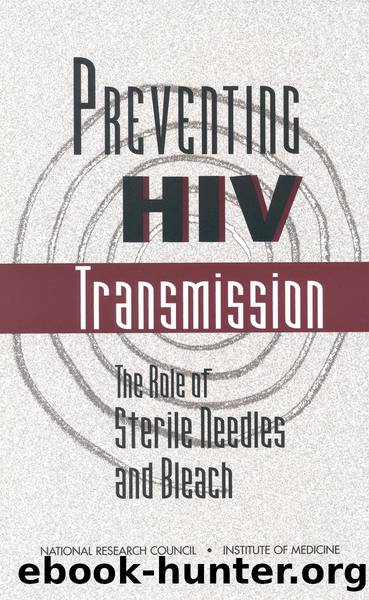Preventing HIV Transmission: The Role of Sterile Needles and Bleach by Panel on Needle Exchange & Bleach Distribution Programs

Author:Panel on Needle Exchange & Bleach Distribution Programs
Language: eng
Format: epub
Tags: Health and Medicine : Diseases - Other
Publisher: NATIONAL ACADEMY PRESS
Published: 1995-09-15T00:00:00+00:00
BLEACH AS A DISINFECTANT
Definition of Terms
Although the terms sterilization and disinfection are widely employed, they are often misused (Block, 1983). Sterilization is the use of physical or chemical procedures to destroy all forms of microbial life, including highly resistant bacterial endospores. Sterilization is frequently accomplished using high-pressure steam autoclaving, ethylene oxide gas, or prolonged exposure to dry heat. Disinfection is the elimination of all vegetative microorganisms and pathogenic viruses, but not bacterial or fungal spores, from an inanimate object. As such, disinfection processes lack the margin of safety achieved through sterilization procedures. Furthermore, the effectiveness of a disinfection procedure is influenced significantly by a number of factors, including the nature and number of contaminating microorganisms, the type and condition of the materials to be disinfected, and the amount of organic matter (such as blood) present (Klein and Deforest, 1965a; Rhame, 1986; Rutala and Weber, 1987; Rutala, 1987; Van Houton and Hayre, 1991).
A germicide is an agent that destroys microorganisms, especially pathogens, on either living or inanimate objects. Disinfectants can be categorized into high-, medium-, and low-level agents based on their potency of germicidal action. Disinfectants that are widely used at present include alcohols, hypochlorites (such as bleach) and other chlorine-containing compounds, formaldehyde, glutaraldehyde, hydrogen peroxide, iodophors, phenolics, and quaternary ammonium compounds. The level of contamination with organic matter of objects to be disinfected is referred to as the bioburden, and it is of particular importance in the disinfection of surfaces contaminated with blood that harbors infectious pathogens. Contact time is defined as the length of time that a contaminated object or surface is exposed to a disinfectant. Cleaning is the removal of foreign (especially organic) material. Decontamination is the removal of pathogenic microorganisms from objects so they are safe to handle.
Download
This site does not store any files on its server. We only index and link to content provided by other sites. Please contact the content providers to delete copyright contents if any and email us, we'll remove relevant links or contents immediately.
| Administration & Medicine Economics | Allied Health Professions |
| Basic Sciences | Dentistry |
| History | Medical Informatics |
| Medicine | Nursing |
| Pharmacology | Psychology |
| Research | Veterinary Medicine |
Periodization Training for Sports by Tudor Bompa(7946)
Why We Sleep: Unlocking the Power of Sleep and Dreams by Matthew Walker(6388)
Paper Towns by Green John(4826)
The Immortal Life of Henrietta Lacks by Rebecca Skloot(4274)
The Sports Rules Book by Human Kinetics(4097)
Dynamic Alignment Through Imagery by Eric Franklin(3935)
ACSM's Complete Guide to Fitness & Health by ACSM(3834)
Kaplan MCAT Organic Chemistry Review: Created for MCAT 2015 (Kaplan Test Prep) by Kaplan(3815)
Introduction to Kinesiology by Shirl J. Hoffman(3634)
Livewired by David Eagleman(3547)
The River of Consciousness by Oliver Sacks(3431)
The Death of the Heart by Elizabeth Bowen(3355)
Alchemy and Alchemists by C. J. S. Thompson(3312)
Descartes' Error by Antonio Damasio(3170)
Bad Pharma by Ben Goldacre(3118)
The Gene: An Intimate History by Siddhartha Mukherjee(2942)
The Emperor of All Maladies: A Biography of Cancer by Siddhartha Mukherjee(2942)
The Fate of Rome: Climate, Disease, and the End of an Empire (The Princeton History of the Ancient World) by Kyle Harper(2893)
Kaplan MCAT Behavioral Sciences Review: Created for MCAT 2015 (Kaplan Test Prep) by Kaplan(2832)
